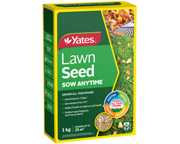Yates Account
Join now
Create a Yates account today!
Sign up to join the Yates Garden Club for monthly e-mails packed with seasonal inspiration, tips for success & exclusive promotions.
Plus if you’re a Garden Club member you can take part in the Yates Growing Community - a blog to share successes, get advice & win prizes in fun challenges along the way!

Forgot password
Enter the email address associated with your account, and we'll email you a new password.

Need a new lawn?
Lawn seed is an economical way to start a fresh new lawn, helping to create a lush green space that will be an area of enjoyment and fun for years to come. Early autumn is a great time to start a new lawn from seed, as the air temperatures are milder but the soil is still warm enough for grass seed to germinate and establish.
Here’s how to start a new lawn from seed:
Step 1: Weed control – weeds will compete with the new lawn so should be controlled. 2 weeks before sowing lawn seed (this allows the weeds to die completely). Yates Zero Super Concentrate Weedkiller can be used a general spray over the area to kill any weeds and existing grasses.
Step 2: Soil preparation – lawn seed should be sown into well drained, firm but not compacted soil that is rich in organic matter. Yates Dynamic Lifter Organic Lawn Food contains composted chicken manure blended with blood and bone, fishmeal and seaweed and mixing this into the existing topsoil will help to create an ideal environment for lawn seeds to grow.
Step 3: Measure – measure the area and calculate the correct amount of lawn seed.
Step 4: Sow – rake the soil surface in straight lines to create shallow furrows. Broadcast the seed evenly over the area. It helps to halve the seed and sow half in an east west direction and the other half in a north south direction. After sowing, lightly cross rake the area to mix the seed into the topsoil.
Step 5: Water – water the area with a fine mist spray. It is very important that the top soil remains moist for the first 14 – 21 days to complete germination. This may require watering several times a day if the weather is hot or windy. As the grass establishes, the number of watering's can be reduced but increase the volume of water at each watering.
Step 6: Mow – mow the grass when it is 5-6 cm high, so you just cut the top 1 cm off the top. This will help to encourage root growth. As the lawn matures, lower the blades of the mower on successive cuts.
It's a great idea to add some bird scaring devices during the sowing phase. Old CDs strung onto bamboo stakes work well. Christmas tinsel and brightly coloured ribbons fluttering in the breeze over your sown area really helps to keep bird losses under control. Some bird species (notably sparrows) are very persistent and may need some extra effort to deter.
Choosing the right lawn seed
There are so many kinds of front and back lawns all around New Zealand, including lawns in sun or shade and areas that are a playground for pets and kids. People also have their own preferences for the type of lawn they want, including soft and upright grasses to tough and running varieties.
To help you choose which lawn seed to use, here are some details about Yates’ most popular lawn seed varieties:
-
Yates Sow Anytime - a blend of stadium grade ryegrass and red fescue that has the unique ability to grow all year round and will germinate at temperatures as low as 3°C. It can be sown at any time throughout the year, producing a deep green, lush lawn even in shade.
-
Yates Tuff Grass – a value for money lawn that’s resistant to wear and tear, so it’s great for areas where pets and kids play. It combines perennial ryegrass and chewings fescue and is easy to establish, germinating in around 7 days.
- Yates Sun & Shade - specially formulated to thrive in shady conditions, although it's also excellent for sunny areas. This makes it a great choice for partially shaded or South-facing lawns. A unique blend of perennial ryegrass, chewings fescue and creeping red fescue delivers a fine-textured lawn with a rich deep green colour. An ideal mixture for oversowing in spring and autumn.
















Share
Share this article on social media